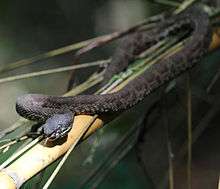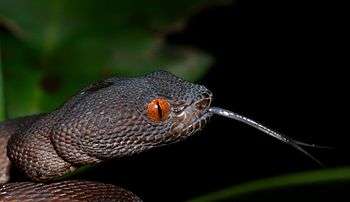Trimeresurus purpureomaculatus
| Trimeresurus purpureomaculatus | |
|---|---|
 | |
| Scientific classification | |
| Kingdom: | Animalia |
| Phylum: | Chordata |
| Subphylum: | Vertebrata |
| Class: | Reptilia |
| Order: | Squamata |
| Suborder: | Serpentes |
| Family: | Viperidae |
| Subfamily: | Crotalinae |
| Genus: | Trimeresurus |
| Species: | T. purpureomaculatus |
| Binomial name | |
| Trimeresurus purpureomaculatus (Gray, 1832) | |
| Synonyms | |
| |
Trimeresurus purpureomaculatus is a venomous pit viper species native to India, Bangladesh and Southeast Asia. Two subspecies are currently recognized, including the nominate subspecies described here.[7]
Description
Males grow to a total length of 66.5 centimetres (26.2 in), females 90 centimetres (35 in). The maximum tail lengths are then 12.5 centimetres (4.9 in) and 14 centimetres (5.5 in) respectively.[8]

Scales in 25-27 longitudinal rows at midbody; 11-13 upper labials, the first partially or completely united with the nasal; supraocular very narrow, sometimes broken into small scales, 12-15 scales between them; head scales small, subequal, tuberculate or granular; temporal scales keeled.[8]
Body color highly variable: above olive, grayish, to dark purplish brown; below whitish, greenish or brown, uniform or spotted with brown; a light line on scale row one bordering ventrals present or absent; head olive, heavily suffused with brown.[8]
Ventrals: males 160-179, females 168-183; subcaudals: males 74-76, females 56-63, paired; hemipenes without spines.[8]
Common names
Mangrove pit viper,[4] mangrove viper,[5] shore pit viper, purple-spotted pit viper,[6] shore pitviper.[9]
Geographic range
Found in India (Assam, Andaman Islands), Bangladesh, Burma, Thailand, West Malaysia, Singapore and Indonesia (Sumatra and Java). The type locality is listed as "Singapore".[2]
Subspecies
| Subspecies[7] | Taxon author[7] | Common name[4] | Geographic range[2] |
|---|---|---|---|
| T. p. andersoni | Theobald, 1868 | Nicobar mangrove pit viper | The Andaman Islands. |
| T. p. purpureomaculatus | (Gray, 1832) | Mangrove pit viper | India (Assam), Bangladesh, Burma, Thailand, West Malaysia, Singapore, Sumatra and Java. |
See also
- List of crotaline species and subspecies
- Trimeresurus by common name
- Trimeresurus by taxonomic synonyms
- Crotalinae by common name
- Crotalinae by taxonomic synonyms
- Snakebite
References
- ↑ Vogel, G.; Grismer, L. & Chan-Ard, T. (2012). "Cryptelytrops purpureomaculatus". IUCN Red List of Threatened Species. Version 2014.3. International Union for Conservation of Nature. Retrieved 31 May 2015.
- 1 2 3 McDiarmid RW, Campbell JA, Touré T. 1999. Snake Species of the World: A Taxonomic and Geographic Reference, Volume 1. Herpetologists' League. 511 pp. ISBN 1-893777-00-6 (series). ISBN 1-893777-01-4 (volume).
- ↑ The Reptile Database. www.reptile-database.org.
- 1 2 3 Mehrtens JM. 1987. Living Snakes of the World in Color. New York: Sterling Publishers. 480 pp. ISBN 0-8069-6460-X.
- 1 2 U.S. Navy. 1991. Poisonous Snakes of the World. US Govt. New York: Dover Publications Inc. 203 pp. ISBN 0-486-26629-X.
- 1 2 Brown JH. 1973. Toxicology and Pharmacology of Venoms from Poisonous Snakes. Springfield, Illinois: Charles C. Thomas. 184 pp. LCCCN 73-229. ISBN 0-398-02808-7.
- 1 2 3 "Trimeresurus purpureomaculatus". Integrated Taxonomic Information System. Retrieved 1 January 2008.
- 1 2 3 4 Leviton AE, Wogan GOU, Koo MS, Zug GR, Lucas RS, Vindum JV. 2003. The Dangerously Venomous Snakes of Myanmar, Illustrated Checklist with Keys. Proc. Cal. Acad. Sci. 54 (24): 407-462.
- ↑ Gumprecht A, Tillack F, Orlov NL, Captain A, Ryabov S. 2004. Asian Pitvipers. Geitje Books. Berlin. 1st Edition. 368 pp. ISBN 3-937975-00-4.
Further reading
- Gray, J.E. 1831. Illustrations of Indian Zoology: chiefly selected from the collection of Major General Hardwicke. Vol. 1, London (1830-1835).
- Gumprecht, A. 2001. Die Bambusottern der Gattung Trimeresurus Lacépède Teil IV: Checkliste der Trimeresurus-Arten Thailands. Sauria 23 (2): 25-32.
- Pope, C.H., & Pope, S.H. 1933. A study of the green pit-vipers of southeastern Asia and Malaysia, commonly identified as Trimeresurus gramineus (Shaw), with description of a new species from Peninsular India. Amer. Mus. Nat. Hist. (620): 1-12.
- Smith, M.A. 1943. The Fauna of British India, Ceylon and Burma, Including the Whole of the Indo-Chinese Sub-region. Reptilia and Amphibia, Vol. III.—Serpentes. Secretary of State for India. (Taylor and Francis, Printers.) London. xii + 583 pp. (Trimeresurus purpureomaculatus purpureomaculatus, pp. 520–521.)
- Whitaker, R. 1978. Birth Record of the Andaman Pit Viper (Trimeresurus purpureomaculatus) J. Bombay Nat. Hist. Soc. 75 (1): 233.
External links
- Trimeresurus purpureomaculatus at the Reptarium.cz Reptile Database. Accessed 15 December 2012.
- Video of T. purpureomaculatus being force-fed on YouTube. Accessed 21 August 2007.
